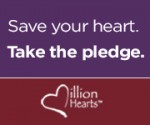Nearly 30 years ago, within a 7 year time span, both of my parents died of cardiovascular disease. I was a young woman in her mid-twenties and they were in their early fifties. My father had high blood pressure, needed to lose weight and to stop smoking. Their lifestyles weren’t health oriented. They started smoking during WWII and continued their entire lives. My dad stopped smoking but the negative health effects took their toll. Within 6 months after stopping smoking, he was dead of a heart attack. For a high school student, this was a traumatic life event. My mom died of a stroke and heart attack about 7 years later. Her weight was normal but she’d also been a smoker for 40 years. Yes, this is their monument, and my father was a stone cutter and owner of Treber Memorials. My family has had a monument business for the past 143 years but it was heartbreaking for us to select his monument.
Why should I share this personal story? Many of us have high blood cholesterol; in fact, about 1 of every 6 adult Americans has high blood cholesterol.
Cholesterol is a waxy, fat-like substance that your body needs. Our body makes most of the cholesterol it needs. It is vital to life and found in all cell membranes. We do get cholesterol from a variety of foods we eat. Dietary cholesterol is only found in animal foods. Cholesterol is contained in meats, poultry, egg yolks and organ meats. Vegetable oils are cholesterol free. But, when you have too much in your blood, it can build up on the walls of your arteries. This can lead to heart disease and stroke. There are no symptoms of high cholesterol. Many people have never had their cholesterol checked, so they don’t know if they’re at risk. A simple blood test can tell you your level. The good news is that there are steps you can take to prevent high cholesterol-or to reduce your levels if they are high. According to the Center for Disease Control and Prevention, here are desirable cholesterol levels:
|
Total cholesterol |
Less than 200 mg/dL |
||
|---|---|---|---|
|
LDL (“bad” cholesterol) |
Less than 100 mg/dL |
||
|
HDL (“good” cholesterol) |
40 mg/dL or higher |
||
|
Triglycerides |
Less than 150 mg/dL |
||
|
|
|||
|
According to the Million Hearts Campaign, the “good” cholesterol can protect you from heart disease and the “bad” can increase your risk of heart disease. It is important to talk to your health care professional about cholesterol and how to lower your bad cholesterol if it’s too high. |
|||
What can you do to prevent high cholesterol? According to the Center for Disease Control and Prevention’s website, all ages can follow these suggestions to reduce their cholesterol levels:
· Eat a healthy diet rich in vegetables and fruits and whole grains. Eating fiber may also help reduce cholesterol. Remember that cholesterol is only found in animal foods so enjoy a diet rich in plant based foods.
· Maintain a healthy weight. Losing weight can reduce cholesterol levels. If you are overweight, reduce your calories and increase your physical activity to lose weight.
· Increase your Physical Activity. Physical activity can help manage your weight and lower cholesterol. Remember to check with your physician before starting an exercise program. Aim for 150 minutes each week of moderate physical activity. 10 minutes at a time is fine. Try going for a 10-minute brisk walk, 3 times a day, five days a week. This will give you 150 minutes of moderate-intensity activity for the week.
· Don’t Smoke. If you smoke, talk to your physician about quitting. If you don’t smoke, don’t start. Smoking increases your risk of heart disease and stroke.
· Treat High Cholesterol. If you have high cholesterol, discuss your treatment plan with your physician. Talk to your doctor about lifestyle changes that you can make to decrease your risk of heart disease.
Find out your cholesterol level and discuss the results with your doctor. Start making these positive lifestyle changes today!
Take the Million Hearts pledge: http://millionhearts.hhs.gov 
Make a commitment to saving your life!
Writer: Michelle Treber, Family and Consumer Sciences Educator, Ohio State University Extension, Pickaway County, Heart of Ohio EERA, treber.1@osu.edu.
Reviewer: Patrice Powers-Barker, Family and Consumer Sciences Educator, Ohio State University Extension, Lucas County, Maumee Valley EERA, powers-barker.1@osu.edu
Sources:
eXtension (May 2012). Retrieved September 18, 2013 from http://www.extension.org/
Healthy Ohio Program available at www.healthyohioprogram.org
How much physical activity do adults need? Retrieved from Center for Disease Control and Prevention website, retrieved September 16, 2013 from http://www.cdc.gov/physicalactivity
International Food Information Council Foundation, (2009). http://www.foodinsight.org/
Million Hearts Campaign available at http://millionhearts.hhs.gov
Schober SE, Carroll MD, Lacher DA, Hirsch R. High serum total cholesterol—an indicator for monitoring cholesterol lowering efforts; U.S. adults, 2005–2006. NCHS data brief no 2, Hyattsville, MD: National Center for Health Statistics. 2007.
What can you do? Center for Disease Control and Prevention website, retrieved September 16, 2013 from http://www.cdc.gov/cholesterol/what_you_can_do.htm


